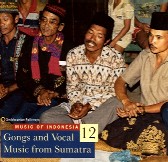 |
Gongs and Vocal Music from Sumatra. Music of Indonesia, vol. 12. Recorded, compiled and annotated by Philip Yampolsky. Produced in collaboration with the Indonesian Society for the Performing Arts. 74 mins. Liner notes 25 pp. Smithsonian Folkways LC9628, 1996. |
In vol. 12, Yampolsky once again provides fascinating documents for the study of the far-flung links that make the cultural history of Southeast Asia such a fertile subject for further exploration. The talempong (Audio 1) and kulintang (Audio 2) recordings are clearly linked to other ensembles and associated musical practices which extend from the southern Philippines, where the relatively well-known kulintang ensemble has been more extensively recorded and studied, to various Indonesian islands, including south Sumatra, Kalimantan and Sulawesi. |
|
Instruments and ensembles in Bali, Lombok, Madura and Java are also related, perhaps somewhat less directly. Each manifestation of this phenomenon features a gong-chime, played either solo or in interlocking parts, usually with drums and larger gongs. In some instances additional instruments are played, such as the rice stalk aerophone that adds a raucous melody to track 1. This volume is less sonically, geographically, and ethnically unified than volume 10, but is considerably more interesting because of that. While the performances again come from a single island, this is the largest of Indonesia’s islands, home to several large ethnic groups with distinctive languages, musical traditions and other social and cultural practices. Many of the examples on volume 11 are also taken from Sumatra, but one would never know it by listening to the two CDs, for the musical practices are so different. Alongside eight tracks devoted to gong ensembles, volume 12 includes one long example (22.5 minutes) of salawat dulang (Audio 3) from the Minangkabau people of West Sumatra and three examples of didong (Audio 4) performed by Gayo from Aceh at the northwestern tip of Sumatra. Both of these genres can be profitably linked to the selections on volume 11: they share a Muslim orientation and many resemblances to music from the Middle East. |
|
The salawat dulang, (Audio 3) performed by two male singers who, after numerous solo exchanges and unison passages, begin to drum on metal trays, is explicitly religious in nature: the singers address matters of Islamic belief and practice. This is a fascinating track that warrants repeated close listening as the singers slip smoothly from one melody to the next, switching between textures seemingly effortlessly. A translation into Indonesian from Bahasa Minangkabau by Firdaus Binulia of Akademi Seni Karawitan Indonesia in Padang Panjang is available on the Folkways Indonesia web site. |
|
|
|
|
introduction | vol
10 | vol 11 | vol 12
|
|